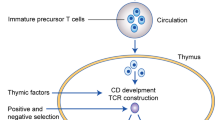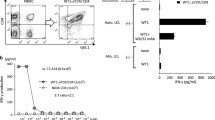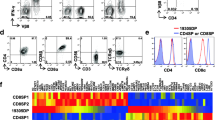Abstract
Purpose: The CD44 v7/8 splice variant that is frequently expressed in cervical carcinoma and rarely expressed in normal tissues displays promising properties as a target antigen for cancer immune therapy. In this study, cytotoxic T lymphocytes (CTLs) were genetically engineered to gain CD44v7/8 target specificity. Methods: Clone 96 (CI96), an established murine cytotoxic T-cell line, and naïve murine T cells were retrovirally transduced with a fusion gene construct encoding for the single chain fragment scFv of the monoclonal antibody VFF17 and for the ζ chain of the T-cell receptor (TCR). The therapeutic potential of genetically engineered T cells was tested in vitro and in vivo. Results: Surface expression of the chimeric TCR on infected Cl96 and naïve T cells was shown by FACS analysis. CD44v7/8-positive target cells were efficiently lysed by transduced Cl96 and naïve T cells, demonstrating the functionality and specificity of the chimeric TCR. In a xenograft BALB/c mouse model, efficient growth retardation of CD44v7/8-positive tumours was mediated by genetically engineered Cl96(VFF17)cyYZ cells. Conclusions: We were able to reprogramme the target specificity of recombinant Cl96 and naïve CTLs resulting in efficient cytolysis of CD44v7/8-positive cervical cancer cells. High transduction rates and the specific cytolysis of CD44v7/8-redirected CTLs are promising tools for an immune gene therapy approach for advanced cervical cancer.





Similar content being viewed by others
Abbreviations
- Ab:
-
Antibody
- CTL:
-
Cytolytic T lymphocyte
- mAb:
-
Monoclonal antibody
- TCR:
-
T-cell receptor
References
Abken H, Hombach A, Heuser C, Reinhold U (2001) A novel strategy in the elimination of disseminated melanoma cells: chimeric receptors endow T cells with tumor specificity. Recent Results Cancer Res 158:249
Altenschmidt U, Kahl R, Moritz D, Schierle BS, Gerstmayer, Wels W, Groner B (1996) Cytolysis of tumor cells expressing the Neu/erbB-2, erbB-3 and erbB-4 receptors by genetically targeted naive T lymphocytes. Clin Cancer Res 2:1001
Altenschmidt U, Klundt E, Groner B (1997) Adoptive transfer of in vitro-targeted, activated T lymphocytes results in total tumor regression. J Immunol 159(11):5509
Appleman LJ, Tzachanis D, Grader-Beck T, van Puijenbroek AA, Boussiotis VA (2001) Helper T cell anergy: from biochemistry to cancer pathophysiology and therapeutics. J Mol Med 78(12):673
Arteaga CL, Hurd SD, Winner AR, Johnson MD, Fendley BM, Forbes JT (1993) Anti-transforming-growth-factor(TGF)-β antibodies inhibit breast-cancer—cell tumorigenicity and increase mouse-spleen natural killer cell activity. J Clin Invest 92:2569
Byrne SN, Halliday GM (2003) High levels of Fas ligand and MHC class II in the absence of CD80 or CD86 expression and a decreased CD4+ T cell infiltration, enables murine skin tumours to progress. Cancer Immunol Immunother 52(6):396
Cabrera T, Lopez-Nevot MA, Gaforio JJ, Ruiz-Cabello F, Garrido F (2003) Analysis of HLA expression in human tumor tissues. Cancer Immunol Immunother 52:1
Chambers CA (2001) The expanding world of co-stimulation: the two-signal model revisited. Trends Immunol 22(4):217
Dall P, Heider KH, Hekele A, von Minckwitz G, Kaufmann M, Ponta H, Herrlich P (1994) Surface protein expression and messenger RNA splicing analysis of CD44 in uterine cervical cancer and normal cervical epithelium. Cancer Res 54(13):3337
Dall P, Hekele A, Ikenberg H, Goppinger A, Bauknecht T, Pfleiderer A, Moll J, Hofmann M, Ponta H, Herrlich P (1996) Increasing incidence of CD44v7/8 epitope expression during uterine cervical carcinogenesis. Int J Cancer 69(2):79
Dall P, Hekele A, Beckmann MW, Bender HG, Herrlich P, Ponta H (1997) Efficient lysis of CD44v7/8-presenting target cells by genetically engineered cytotoxic T-lymphocytes: a model for immunogene therapy of cervical cancer. Gynecol Oncol 66:209
Darcy PK, Kershaw MH, Trapani JA, Smyth MJ (1998) Expression in cytotoxic T lymphocytes of a single-chain anti-carcinoembryonic antigen antibody: redirected Fas ligand-mediated lysis of colon carcinoma. Eur J Immunol 28(5):1663
Durst B (2000) Untersuchung der Expression des CD44-Glykoporteins bei gynäkologischen Tumoren und Entwicklung eines Gentherapieansatzes mit rekombinanten zytotoxischen T-Zellen (rCTL). Inaugural Dissertation. Mathematisch-Naturwissenschaftliche Fakultät der Heinrich-Heine-Universität Düsseldorf
Esser MT, Dinglasan RD, Krishnamurthy B, Gullo CA, Graham MB, Braciale VL (1999) IL-2 induces Fas ligand/Fas (CD95L/CD95) cytotoxicity in CD8+ and CD4+ T lymphocyte clones. J Immunol 158(12):5612
Fischer WH, Thor Straten P, Terheyden P, Becker JC (1999) Function and dysfunction of CD4(+) T cells in the immune response to melanoma. Cancer Immunol Immunother 48(7):363
Foekens JA, Dall P, Klinjn JG, Skroch-Angel P, Claassen CJ, Look MP, Ponta H, van Putten WL, Herrlich P, Henzen-Logmans SC (1999) Prognostic value of CD44 variant expression in primary breast cancer. Int J Cancer 84(3):209
Foreman KE, Wrone-Smith T, Krueger AE, Nickoloff BJ (1999) Expression of costimulatory molecules CD80 and/or CD86 by a Kaposi’s sarcoma tumor cell line induces differential T cell activation and proliferation. Clin Immunol 91(3):345
Garcia-Lora A, Algarra I, Garrido F (2003) MHC class I antigens, immune surveillance, and tumor immune escape. J Cell Physiol 195(3):346
Gueckel B, Meuer S, Bastert G, Wallwiener D (2003) Tumor-associated antigens as tools in immunodiagnostics and immumotherapy of breast cancer. J Obstet Gynaecol 63:130
Hekele A, Dall P, Moritz D, Wels W, Groner B, Herrlich P, Ponta H (1996) Growth retardation of tumors by adoptive transfer of cytotoxic T lymphocytes reprogrammed by CD44v6-specific scFv-kappa-chimera. Int J Cancer 68:232
Hombach A, Schneider C, Sent D, Koch D, Willemsen RA, Diehl V, Kruis W, Bolhuis RL, Pohl C, Abken H (2000) An entirely humanized CD3 zeta-chain signaling receptor that directs peripheral blood t cells to specific lysis of carcinoembryonic antigen-positive tumor cells. Int J Cancer 88(1):115
Imam H, Eriksson B, Oberg K (2000) Expression of CD44 variant isoforms and association to the benign form of endocrine pancreatic tumours. Ann Oncol 11(3):295
Iwasake T, Hara K, Hayashi Y, Yokoyama M, Hachisuga T, Fukuda K, Okuma Y, Sugimori H (1991) Antitumor effects of human recombinant interferon-gamma and tumor necrosis necrosis factor on five cervical adenocarcinoma cell lines, in vivo and in vitro. Gynecol Oncol 42(1):39
Keil O, Bojahr H, Prisack HB, Dall P (2001) Novel lipophilic chloroquine analogues for a highly efficient gene transfer into gynecological tumours. Bioorg Med Chem Lett 11:21611
Kim KB, Choi YH, Kim IK, Chung CW, Kim BJ, Park YM, Jung YK (2002) Potentiation of Fas- and Trail-mediated apoptosis by IFN-gamma in A549 lung epithelial cells: enhancement of caspase-8 expression through IFN-response element. Cytokines 20(6):283
Miyazono K, Suzuki H, Imamura T (2003) Regulation of TGF-beta signaling and its roles in progression of tumors. Cancer Sci 94(3):230
Morgenstern JP, Land H (1990) Advanced mammalian gene transfer: retroviral vectors with multiple drug selection markers and a complementary helper-free packaging cell line. Nucleic Acids Res 18:3587
Nestle FO (2000) Dendritic cell vaccination for cancer therapy. Oncogene 19:6673
Nilges K, Hohn H, Pilch H, Neukirch C, Freitag K, Talbot PJ, Maeurer MJ (2003) Human papillomavirus type 16 E7 peptide-directed CD8+ T cells from patients with cervical cancer are cross-reactive with the coronavirus NS2 protein. J Virol 77(9):5464
Nozoe T, Yasuda M, Honda M, Inutsuka S, Korenaga D (2003) Fas ligand expression is correlated with metastasis in colorectal carcinoma. Oncology 65(1):83
Pilch H, Hoehn H, Schmidt M, Steiner E, Tanner B, Seufert R, Maeurer M (2002) CD8+CD45RA+CD27-CD28-T-cell subset in PBL of cervical cancer patients representing CD8+ T cells being able to recognize cervical cancer associated antigens provided by HPV 16 E7. Zentralbl Gynakol 124(8–9):406
Pinthus JH, Waks T, Kaufman-Francis K, Schindler DG, Harmelin A, Kanety H, Ramon J, Eshar Z (2003) Immuno gene therapy of established prostate tumours using chimeric receptor redirected human lymphocytes. Cancer Res 63:2470
Pollok KE, Hanenberg H, Noblitt TW, Schroeder WL, Kato I, Emanuel D, Williams DA (1998) High-efficiency gene transfer into normal and adenosine deaminase-deficient T lymphocytes is mediated by transduction on recombinant fibronectin fragments. J Virol 72(6):4882
Restifo NP, Kawakami Y, Marincola F, Shamamian P, Taggarse A, Esqquviel F, Rosenberg SA (1993) Moelcular mechanisms used by tumors to escape immune recognition: immunogenetic therapy and the cell biology of major histocompatibilty complex class I. J Immunother 14:182
Rosenberg SA, Yang JC, Schwartzentruber DJ, Hwu P, Marincola FM, Topalian SL, Restifo NP, Dudley ME, Schwarz SL, Spiess PJ, Wunderlich JR, Parkhurst MR, Kawakami Y, Seipp CA, Einhorn JH, White DE (1998) Immunologic and therapeutic evaluation of a synthetic peptide vaccine for the treatment of patients with metastatic melanoma. Nat Med 4:321
Saller RM, Indraccolo S, Coppola V, Esposito G, Stange J, Mitzner S, Amadori A, Salmons B, Gunzburg WH (2002) Encapsulated cells producing retroviral vectors for in vivo gene transfer. J Gene Med 4(2):150
Yang AS, Lattime EC (2003) Tumor-induced interleukin 10 suppresses the ability of splenic dendritic cells to stimulate CD4 and CD8 T-cell responses. Cancer Res 63(9):2150
Author information
Authors and Affiliations
Corresponding author
Rights and permissions
About this article
Cite this article
Dall, P., Herrmann, I., Durst, B. et al. In vivo cervical cancer growth inhibition by genetically engineered cytotoxic T cells. Cancer Immunol Immunother 54, 51–60 (2005). https://doi.org/10.1007/s00262-004-0569-x
Received:
Accepted:
Published:
Issue Date:
DOI: https://doi.org/10.1007/s00262-004-0569-x




